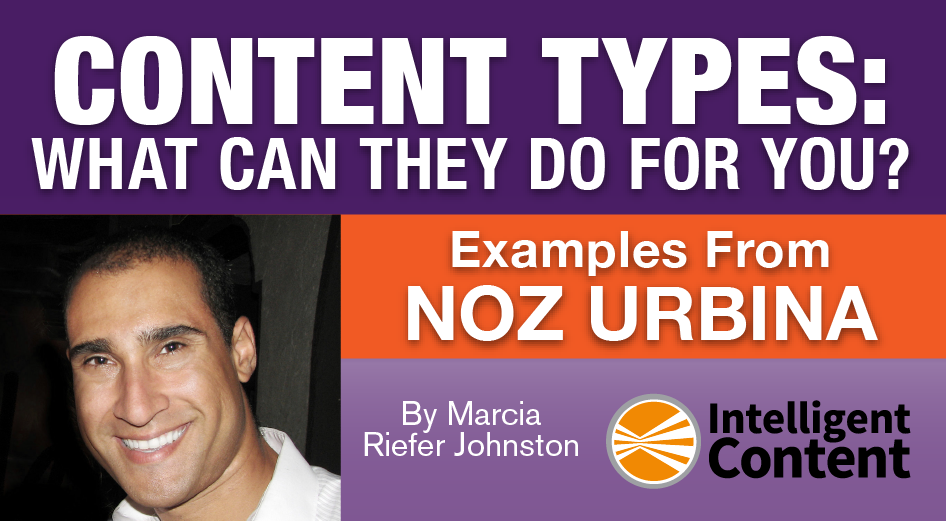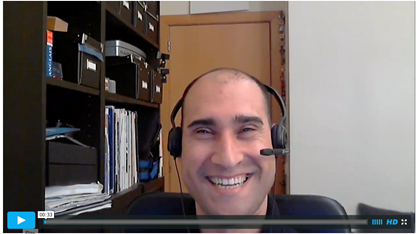Have you ever wondered, What are these “content types” that I keep hearing about, and why should I care? A content type is a kind of content used repeatedly that has a standardized (agreed-on) structure. Content types have several advantages over unstructured (inconsistently structured) content:
- They give content creators patterns of organization (maybe even templates) to work with, simplifying their job and ensuring that they include all necessary content elements.
- They provide a common communication tool for content creators, UI developers, stylesheet creators, and print and publishing people.
- They give consumers a consistent – and, therefore, more pleasant and helpful – experience.
- They create opportunities for content reuse that don’t exist when content is left unstructured.
- They prepare content for automation.
In this article, I look at the content-type examples mentioned most frequently by author and content strategist Noz Urbina: news story, product description, and podcast. These examples have helped me understand the value of content types. I hope they will help you, too, no matter what types of content you work with.
A few general points about content types
Before digging into the examples, you’ll find it helpful to know a few things that apply to all content types.
Content types work for people
Content creators and consumers alike find the structure of a content type (like a news story or product description) easy to internalize. Noz puts it this way:
“The human brain likes structure and consistency. We like being able to learn a system of content. That makes us more positive about the content we consume, whether or not we’re aware of it.”
When content creators all organize a certain content type – like a news story or product description – the same way, consumers can “skim and scan” that content faster and “enjoy consuming it more,” Noz says. On the other hand, he adds, disorganized content frustrates and confuses us.
Content types work for machines
For machines to recognize a content type’s elements (like headlines or model numbers), the elements need to be tagged with metadata indicating semantic categories for those elements. Semantic means “meaning.” A semantic category tells machines what a piece of content means – what kind of content it is – as opposed to what it says.
When consistently structured content is semantically tagged, machines can understand it and, potentially, act on it in powerful – intelligent – ways.
In other words, semantic categories enable machines to “know” things about content that people know just by looking.
Content type 1: News story
Noz’s go-to example of a content type is the news story. Everyone recognizes this content type and its elements (semantic categories): headline, byline, photo caption, etc. The consistent structure of this content type enables people to create and consume news stories in a familiar, predictable way.
This consistency, when coupled with semantic tagging, also enables machines to process news stories in powerful ways that they couldn’t otherwise – for example, listing headlines from today’s news or pulling lead paragraphs to create a set of previews.
This news story (which contains a grain of truth – Noz did teach an adaptive-content workshop in Redmond on May 18) contains the typical elements, or semantic categories, that belong to this content type.
Content type 2: Product description
Like news stories, product descriptions have a typical set of elements (semantic categories): product overview, product name, model number, etc. If you’re part of a company that creates product descriptions, and if those descriptions use inconsistent structures or metadata tags, your company is missing opportunities to make those descriptions easier to create, consume, and automate.
Even if you can’t read Vietnamese, you instantly recognize this content type as a product description. The consistent structure enables people to “skim and scan.” When consistently structured content is semantically tagged, machines can understand and act on it in powerful ways.
(Image borrowed from Noz’s presentation)
Formalized content types, like product descriptions, enable teams from various parts of an organization to work together. For example (as shown here), you can map the elements of a product description onto wireframes for various types of output. You might say, for example, “We need to show product name, model number, and tagline in that order everyplace, and we’ll never have two taglines.” Or you might say, “We’ll have lots of images, so be ready for that.”
If teams don’t plan their content properly, Noz says, “chaos ensues.”
Well-defined content types – like the product description shown in this example – move you away from creating for specific channels or devices to creating for any channel or device.
(Image borrowed from Noz’s presentation)
Content types become most powerful when “machines get it, too,” says Noz. When you implement your content type in a computer system, the system can reach in and pull out these elements. When someone comes out with a new format – Microsoft HoloLens, for example – you can say, “Okay, here’s where taglines go on this thing.”
Defining content types gives us a way to future-proof our content, Noz says.
A content type – like product description, shown here – may be set up to change (adapt) the content according to any number of variables – in this case, the audience. This example comes from a system that contains multiple short descriptions, each tailored to a unique audience. The system delivers the appropriate short description for the audience it detects. In other words, the content in the blue highlighted box varies with the audience. Modern web systems can do this, Noz says. Not all the tools are equal, “but the capacity exists to adapt our content to places, interests, people, times, and devices.” When people talk about adaptive content or personalized content, this is what they’re talking about.
(Image borrowed from Noz’s presentation)
Content type 3: Podcast
Since participating in a CMI Content Marketing Next podcast, Noz often cites this program as following a well-structured content type. This podcast follows a consistent structure that lends itself to reuse.
This timeline shows the structure of the podcasts in the CMI Content Marketing Next series. Each podcast includes the same sections (which qualify as semantic categories even though they’re not tagged with metadata): What’s New, What’s Now, What’s Next; Blast the Buzzword; and the Hot Seat.
CMI might, for example, create a blog post or podcast that gathers a number of “What’s New” sections by various interviewees. Or it might create a piece on books that have been recommended by interviewees during the “hot-seat” portion of the show.
Of course, CMI would have to gather and reuse this content manually. Their system isn’t set up to generate these new assets automatically. But still, the structure of this content type counts as a step toward intelligent content. As Noz says,
“By having the semantics and the structure, [organizations] can reuse their content in new ways, even if they have to do it by copy-and-paste … They can create new assets, which get more leverage … They can create audio compilations, or they can get transcripts and create compilation blog posts … That’s planning and forethought without the huge investment in a CMS … If you are a big business, you won’t be able to scale it. But if you’re a small business, then the mandrolic approach can work for you to get more bang for your buck.”
A note on terminology
You sometimes hear people, including Noz, use the term content model in the sense that I’m using content type. Here are the definitions of these two terms according to The Language of Content Strategy by Scott Abel and Rahel Anne Bailie.
- Content type: A specification for a structured, standardized, reusable, and mutually exclusive kind of information entry. —Jonathon Colman
- Content model: A formal representation of structured content as a collection of content types and their interrelationships. —Cleve Gibbon
In this article, I use the terms according to these definitions. This usage is consistent with most of what I read.
For more on content models, see these posts:
- Content Models: Getting Started with Structured Content by Natalya Minkovsky
- The Technology Behind The Language of Content Strategy by Richard Hamilton
Summary
If you wonder how to get started with intelligent content, consider formalizing the structure of your team’s most common content types. You don’t have to talk about metadata or semantic categories right away. Step One is simply getting everyone involved to agree on what elements to include in content of that type and, ideally, what labels you’ll all use to describe those elements. By doing so – even if your organization isn’t ready to invest in a CMS or other specialized tools and technologies – you accomplish several things:
- You create tools for communicating with other content teams in your organization.
- You give content creators patterns of organization (maybe even templates) to work with, simplifying their job and ensuring that they include all necessary content elements.
- You give consumers a consistent – and, therefore, more pleasant and helpful – experience.
- You create opportunities for content reuse that don’t exist when content is left unstructured.
- You prepare your content for automation.
Want to move your organization toward intelligent content? Start by defining your content types.
About Noz Urbina
The founder of Urbina Consulting, Noz (@nozurbina) is a globally recognized content strategy consultant and trainer specializing in marketing and technical communication for multinational clients. He delivers frequent workshops and keynotes on cutting-edge content techniques. Noz is co-author with Rahel Anne Bailie of the book Content Strategy: Connecting the dots between business, brand, and benefits.
Learn more
To hear from Noz himself on content types and related topics, listen here:
- CMI Content Marketing Next podcast on adaptive content and customer experience
- Bath Content Strategy Meetup presentation on omnichannel and adaptive content
- Insert Content Here podcast on adaptive content
Unless otherwise noted, the quotations in this article come from these three sources or from Noz’s emails.
For a story that demonstrates the impact of standardizing a content type – in this case, the hospital-discharge summary – across several organizations, see The Power of Consistent Content Structure: A Health Care Story.
Cover image by Joseph Kalinowski/Content Marketing Institute








